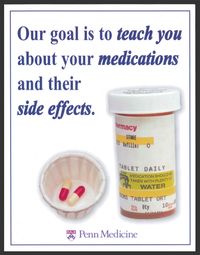
Penn Medicine has set a goal to eliminate preventable readmissions within seven days after patients are discharged from the hospital at its three hospitals by July 1, 2014. Since the kick-off of this effort in 2011, a number of initiatives have successfully reduced these readmissions but a key component in helping Penn’s health system reach its objective is medication safety.
Nationally, 17 percent of hospital readmissions -– nearly one in five -- are related to medication issues. It’s not surprising, given the complexity of today’s medication therapy. At the Hospital of the University of Pennsylvania, where many patients have serious medical problems, it’s not unusual for them to be on 10 medications … or more! Patients may have trouble following new medication regimens after they leave the hospital and that, in turn, can land them back in the hospital if their symptoms aren’t controlled as a result, or if new drugs interact with one another due to dosing mishaps.
A program at HUP which brings pharmacists to the bedside is helping to reverse the trend. The health system’s program is the only one of its kind in the city and one of few in the entire country.
As part of the program, each of HUP’s patient-care units has a dedicated pharmacist on site and easily accessible to both patients and the health-care staff. The pharmacist meets with patients within 24 hours of their admission to the unit, reviewing the patients’ current medication regimen and determining how much they know about their meds. According to
Gene Gibson, PharmD, associate director of Pharmacoeconomics, studies have shown that, nationally, admission documents contain an error in medication information 30 percent of the time: “Either the drug name, frequency or dosage is wrong or it’s missing entirely.”
With the pharmacist’s focus strictly on medications -– and compliance -- patients often reveal information in that initial discussion that may not come to light when speaking with other members of the health-care team. For example, one patient at HUP had been admitted and discharged from two other hospitals within the last two months. She told the pharmacist that she had no way to get to a pharmacy and, as a result, had not picked up any medications since her last discharge. Working with the unit’s social worker, the pharmacist found a pharmacy in her neighborhood that would deliver her meds after she was discharged. As Gibson noted, “You wouldn’t normally find out this kind of information unless you were specifically discussing medications.”
The pharmacist becomes a familiar face to inpatients, educating them about any new medications they’re put on and possible side effects, and answering questions. Each patient also receives a card with the pharmacist’s name and contact information as well as the number for HUP’s drug information center, which serves as a helpline for patients -– and their care providers -– after discharge. Prior to a patient leaving, the pharmacist reviews the final medications list on the discharge document and goes over it with the patient to make sure it’s fully understood.
Gibson said that before the program began, HUP pharmacists were doing about 7,000 interventions a year (checking drug orders to make sure there are no errors). Now, with the additional pharmacists brought on board to staff the program, they are doing approximately 8,200 interventions a month!
According to patient satisfaction surveys, patients like the change. Since the program started, HUP’s average HCAHPS (Hospital Consumer Assessment of Healthcare Providers and Systems) score on medication questions has jumped substantially, with monthly ratings reaching as high as more than 95 percent of hospitals in the country.
The new program benefits the unit’s health-care team as well. As an active member of the unit’s medical team who goes on daily rounds, the pharmacist helps make decisions about drug therapy. “It gives them the opportunity to guide therapy, rather than react to it.”
And it’s a ‘win’ for the pharmacists themselves. “They find it very gratifying to work so closely with patients.”